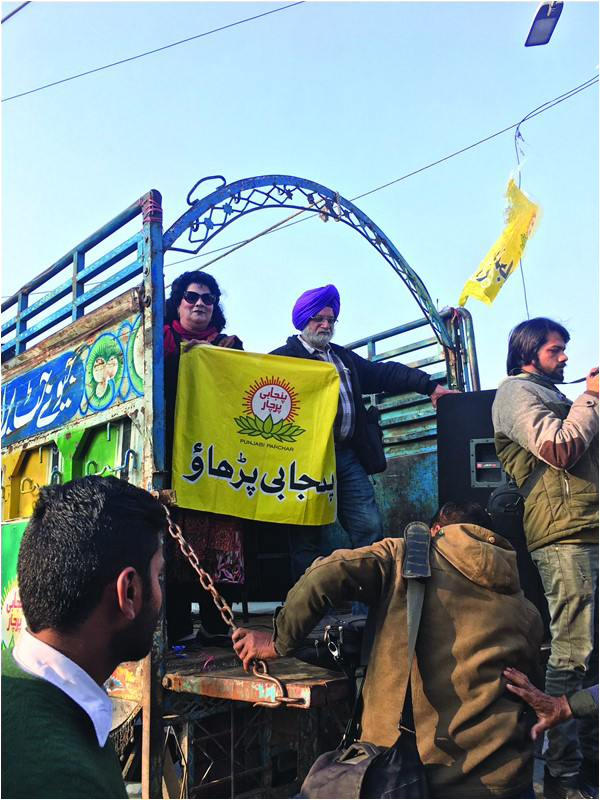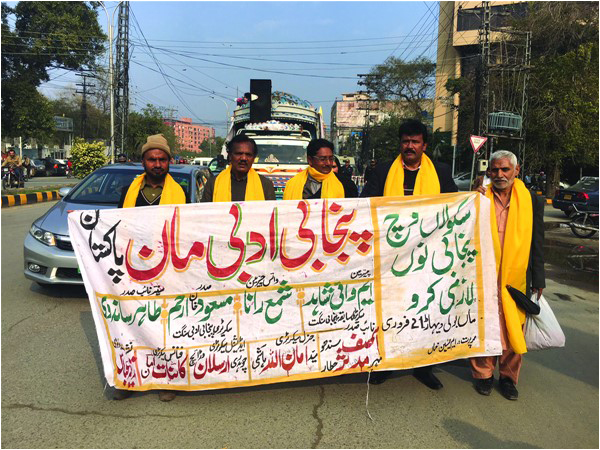One week in the life of a mother tongue
By Ammara Ahmad
The Friday Times : March 1, 2019
Lahore was witness to intense activity by enthusiasts and scholars of Punjabi. Ammara Ahmad takes us to the frontlines

Some of the panelists at the second Punjabi conference to be held at LUMS
Things may be looking up for the old and rich language of the Land of Five Rivers – even though it has been neglected for decades. Punjabi language activists celebrated February as Mother Language Month through a number of protests, seminars, conferences and festivals.
Love of the Punjabi language brought a number of people to the streets. We all gathered outside Lahore’s iconic Press Club at the foot of the Shimla Pahari on the afternoon of the 21st of February. Lahore was having sunny days after a string of rains. A truck full of people was leading the march and making a number of announcements in Punjabi while half a dozen people looked down.
School children sporting yellow P-caps were chanting “Bol Punjabi” (Speak Punjabi) every now and then. The spot is at an intersection of the Egerton, Abbott and Davis roads – three very busy thoroughfares of Lahore that are each laced with many prominent buildings.

The dozen or so Punjabi language activists, writers and poets were also present to represent their organizations. Many of these activists represent progressive movements. The language activists are starting to become something of a fixture: hundreds of people were present, along with children, and most of them appear in protests or Punjabi events often.
This protest, that traditionally begins at the Lahore Press Club in the afternoon of Mother Language Day (21st of February ) and ends at Charing Cross in front of the Punjab Assembly, has been taking place for many years.
However, this year there was a reason to celebrate. Punjabi Parchar and Punjabi Adabi Board had appealed to the Lahore High Court that the language should be made compulsory for primary school students, from class one to five, in Punjab. The High Court has now ordered the Punjab Cabinet to “place” the bill before the Provincial Government. Whether the historic bill will be approved or not is still an open question, but it is always heartening for Punjabi language activists, who often complain that the officials and bureaucracy are content to sideline Punjabi in favour of Urdu.
Parveen Malik, the President of the Punjabi Adabi Board, lauded this step while Ahmed Raza, who represents Punjabi Parchar, gave the Punjab Assembly a deadline of two months. He added that after the 21st of April, he and his fellow Punjabi activists would go on a hunger strike in front of the assembly itself.
The experts attributed this tenacity of the Punjabi language to the lower economic strata – which have still not adopted other languages closer to ruling elites
***
Simultaneously this week, there was a three-day conference at the Lahore College for Women where dozens of papers were presented in Punjabi and on issues related to the region of Punjab. The papers discussed a staggering number of modern and classical poet in Punjabi, along with topics like progressive movements, feminism, expressions of self and motifs of mysticism among others. The speakers were young students, some with fresh PhDs, but also scholars, activists, and writers from Pakistan and the larger diaspora.
***
And last but not least, this year, the Lahore University of Management Sciences (LUMS) organized their second annual Punjab conference. More specifically, the conference was organized by the Mushtaq Ahmad Gurmani School of Humanities and Social Sciences. Syed Babar Ali and the school’s academic leadership took a personal interest in the event. They were able to come up with an eclectic mix of speakers and topics.
Professor Javed Majeed delivered the inaugural lecture. He holds a doctorate in English Language and Literature from Oxford and now teaches at King’s College London. He presented his research on the efforts of Sir George Abraham Grierson, an Irish linguist and orientalist who served as a civil servant in British India. He published the Linguistic Survey of India in 1928, after decades of research and surveying, which was 19 volumes thick. However, Majeed pointed out, some of the problems in the survey and Grierson’s own approach had a lasting impact on Indian history. Ultimately, Grierson distinguished various nationalities by language and attempted to define how these languages are differentiated from one another despite being similar. He was also a firm believer that languages like Sanskrit, Punjabi and others must be taught in universities. Majeed’s in-depth presentations left many questions open – and a heated discussion followed.

Ajay Bhardwaj, a documentary filmmaker from Ludhiana, currently working on his doctorate in the University of British Columbia in Canada, presented his film Kitte Mil Vey Mahi (Where the twain shall meet). The movie was a poignant representation of the syncretic culture of rural Punjab that still persists in India. It focuses on how those from the fringes of the society – low castes, revolutionaries, the rural poor and gypsies – still find space for themselves in the environs of the shrines of long-dead mystics. The documentary lacks a narration and instead features detailed interviews of various people – activists, old women who are due to receive a pension, poets and even Maoist rebels. The discussion that followed was led by academic Khola Cheema and writer Ishtiaq Ahmed, along with Bhardwaj himself. Everyone appreciated that the documentary gave voice to the groups which are lowest in the social hierarchy of Punjab because of caste discrimination and poverty. These groups are never a part of the debate around Punjab, the 1947 Partition and related issues. They need representation through independent filmmaking – on this point the participants at the conference all agreed.
A session on the “New histories of Lahore” brought writers like Haroon Khalid and Tahir Kamran together. Ammara Maqsood moderated the session and Ghafir Shehzad, an Auqaaf Department official, was also present on the panel. Khalid mentioned how the people’s history and narrative of a place differ from the official version. Shehzad, the Auqaaf official, narrated the significance of shrines and how the community owns them. He added that years of litigation could follow if the government tries to renovate a shrine because different members of the community have different expectations and claims. Eventually, everyone on the panel and in the room started lamenting the role of the previous Punjab government for wreaking havoc with heritage sites without paying any attention to vociferous protesters.

No conference on Punjab or Punjabi can be complete without one or more sessions on the 1947 Partition of British India, which ripped Punjab apart brutally to be apportioned between two successor states. Professor Farukh Khan’s work was highlighted at the conference. He has produced a documentary that records the narratives of women survivors of Partition in the Pakistani Punjab. The documentary is titled the Stories of the Broken Self. Dr. Pippa Virdee led the discussion that followed the film screening. The filmmaker noted that he had shown his film all over the world but the viewers in Delhi became angry and declared the film “one-sided”.
Ilyas Chattha, a writer and academic, shared his research findings on the Partition riots in areas surrounding Gujranwala.
Sara Kazmi conducted the session on “Resistance Poetry from Punjab”. Well-known names like Tauqeer Chughtai, Zubair Ahmed, Shakeel Ahmed Tahiri and Anjum Qureshi were on the panel. They all endorsed the idea that Punjabi has historically been a language of resistance and has survived despite all the suppression. They attributed this tenacity of the Punjabi language to the lower economic strata – which have still not adopted other languages that are closer to ruling elites. Poets like Najam Hussain Syed, Mushtaq Soofi, Ashoo Lal Faqir and Nasreen Anjum Bhatti were appreciated in this session.
Academic Zainab Sattar led the session on teaching regional languages and literature and Ashok Kumar, a Sindhi professor from Mithi who is currently teaching at the Punjab University, also expressed his views on teaching Punjabi. Kumar shared his observation that unlike Sindhi students, Punjabi students often don’t know the districts or villages that their forefathers come from and display little pride in their mother language or dialect.
Dr. Anne Murphy presented her thesis on Baba Guru Nanak and outlined how his pictorial representation has evolved through the centuries. He has slowly become a more sophisticated, docile and less rural version of his old self. This change of appearance has also affected how his followers and admirers interpret his poetry.
There was an exciting session on the Dictionaries of Punjab led by Ali Usman Qasmi. Maqsood Saqibi said that dictionaries are a colonial enterprise – before them the language proliferated organically. The question of the myriad dialects of Punjabi and whether they allow for a universal dictionary or even teaching method came under discussion. Jamil Pal, the writer who has produced a “qaida” in Punjabi, said that he had adopted the easiest of the dialects, Majhi, for lessons. Tahir Aseer has developed a dictionary of Punjabi, but it is in Campbelpuri dialect, though he says any Punjabi can comprehend it with ease. In the session on Shahmukhi Punjabi and digital learning, Prof. Gurpreet Singh Lehal presented his software which can translate Gurmukhi script into Shahmukhi and vice versa. The software is free, easy to use and requires merely scans of the document that needs translation. With this, Prof. Lehal expressed his hope that he had played a role in bridging the gap between the literature of two Punjabs – which have been divided by script in addition to religion and political borders.
There were some excellent sessions on the new fiction in Punjabi, cinema, radical politics, the political economy of the region’s agriculture and young subalterns as well. These panels featured big names in contemporary Punjabi culture and attracted a lot of attention from their young fans.
The conference was well attended despite the famed Lahore Literary Festival (LLF) taking place simultaneously on the other side of town. Most of the sessions were fully or partially conducted in Punjabi, unlike last year. The speakers, as well as the guests and attendees, gradually became more comfortable with the language.
Having provided much food for thought, the sessions were concluded on the last day with an equally nourishing rendition of Heer. Let’s hope that this intellectual caravan of Punjab keeps moving forward and more young people continue joining it!
The writer is based in Lahore and tweets at @ammarawrites. Her work is available on www.ammaraahmad.com